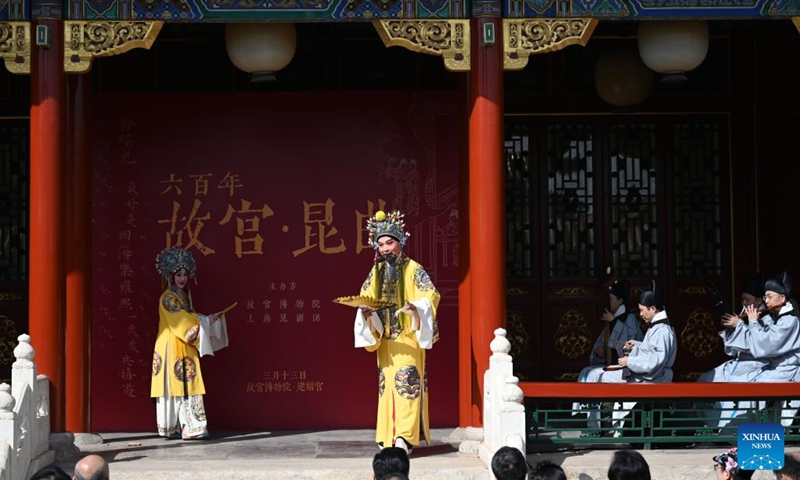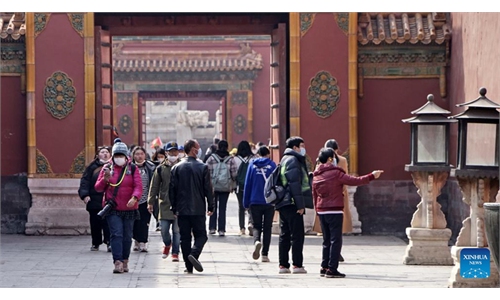ARTS / THEATER
Enlivening Palace Museum’s Kunqu Opera record creates new way of heritage preservation

Kunqu opera performers Li An (2nd L) and Yu Bin enact in an excerpt of the traditional repertoire Palace of the Eternal Youth at the Palace Museum in Beijing, capital of China, March 13, 2023. The Palace Museum and Shanghai Kunqu Opera Troupe signed a strategic cooperation agreement here Tuesday to restage Chinese classic operas.(Photo: Xinhua)
A few days ago, the Palace Museum and the Shanghai Kunqu Opera Troupe signed a cooperation agreement on academic research, creation and promotion of the Kunqu Opera. The cooperation brought some of the 600-year-old opera plays back to life, creating an effective way to promote traditional culture.
The Palace Museum is one of the largest museums of ancient Chinese culture and art in China, boasting a history of 600 years, it used to be the Forbidden City where the emperors of China’s Ming and Qing dynasties lived and conducted state affairs from 1420 to 1911 and was turned into a museum after the fall of China’s Feudalism in 1925.
The Kunqu Opera is one of the oldest genres of opera in China created in the early Ming Dynasty(1368-1644). Featuring mild and sentimental melodies, poetic lines and graceful gestures, it can best represent the traditional Chinese aesthetics. It had flourished for about 100 years before its decline, due to its slow and hermetic style. After the People’s Republic of China was founded in 1949, the Kunqu Opera was put under state protection. In 2006, it was registered on the first lists of intangible national cultural heritage and the intangible cultural heritage by UNESCO in 2008.
The collaboration between these two world cultural heritage items is a good attempt to preserve of this opera, which is really worth encouraging.
According to the Shanghai Kunqu Opera Troupe, this cooperative project is “a dream come true after three years. We aim to let the opera relics housed in the Palace Museum come to life.”
Some traditional plays recorded in the Qing Dynasty archives will be selected and put on show, including those adapted from the classic works of Chinese literature such as the Three Kingdoms, the Outlaws of the Marsh and Journey to the West. In addition, the troupe will also recover a series of plays - the set programs performed on different festivals such as the Chinese New Year, the Mid-Autumn Festival and Winter Solstice and perform them during these festivals accordingly.
Finally, the troupe will also conduct research on the Kunqu Opera’s music, costumes, makeup and props. In particular, it will study the imperial court music collected in the Palace Museum, such as those tunes used in religious rituals, grand ceremonies and state banquets during the Qing Dynasty in order to enrich the music of the Kunqu Opera and enliven traditional Chinese music.
In 2014, the Imperial Opera Research Institute of the Palace Museum was founded to engage in reorganizing the traditional opera archives and relics as well as their publication. After joint research with the Palace Museum, the Shanghai Kunqu Opera Troupe resumed the only full edition of the famous play Peony Pavilion in China containing 55 scenes, which was well-received among audiences.
With the social changes, traditional operas have lost popularity in time, but the recent practice of putting on new plays have helped them take on a fresh look. In fact, there has always been a tradition for Chinese people to watch local operas as its major type of entertainment during festivals, especially in the rural areas. The stories told in the plays are all closely related to people’s life, code of conduct and cultural values.
Unfortunately, many plays have been lost. According to an Kunqu Opera inheritor, out of the 700 plays, only less than 200 have been performed at high-quality level during the past decades. Comparatively speaking, the Western classic operas, also with a history of hundreds of years, are still very popular now. Some experts say that,“While preserving the core content, they have kept changing form, especially in the organization of plots to better cater to the modern stage and express the conflicts of modern life.”
It is good to see that in presenting the new edition of the masterpiece Peony Pavilion, the Shanghai Kunqu Opera Troupe put the story in a broader social background by highlighting the conflict between ideal and reality. While preserving its original style, it depicted the aesthetic pursuit of the modern people. In this sense, the efforts of the Shanghai Kunqu Opera Troupe have made a good attempt in digging deeper into historical records and creatively preserving the Kunqu Opera as well as the traditional Chinese culture.

